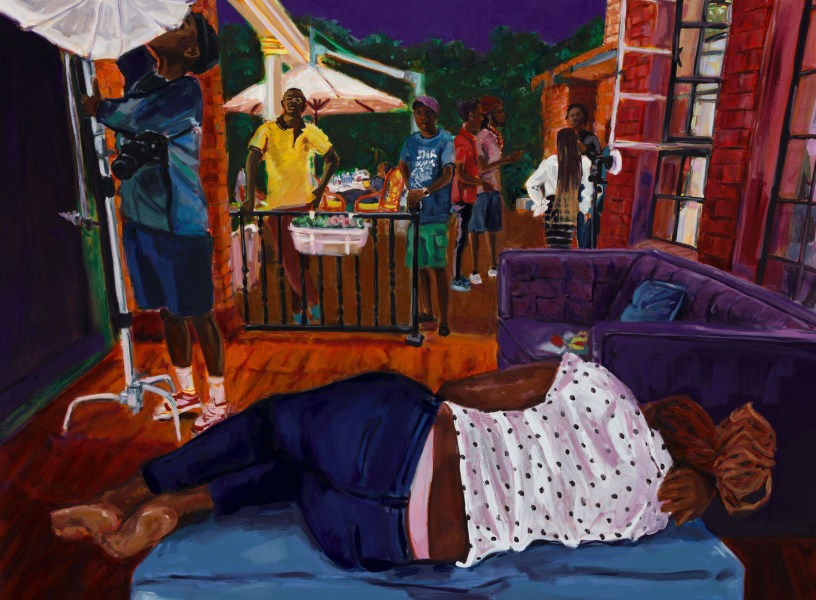
Wangari Mathenge: Tidal Wave of Color
Roberts Projects is pleased to present Tidal Wave of Colour, the newest body of work by artist Wangari Mathenge. This series, Mathenge’s first major solo show in the United States, is composed of nine paintings that range from the intimate to the immersive. The title takes its inspiration from civil rights icon Malcolm X, who used the phrase to capture the post-second World War zeitgeist of global revolution; between 1945 to 1955, ideas about liberation and independence permeated the world; and as a result, Africa, Asia, and Latin America revolted in pursuit of decolonization. On her journey to becoming an artist, Mathenge discovered that she herself was in the midst of her own revolution. In re-imagining herself throughout this new body of work, Mathenge reinterprets iconic works etched deep into art history and in reworking the familiarity of the canon, Mathenge leans into the transcendent elements of her artistic practice, reclaiming a quiet power that resounds.
Before actualizing her desire of becoming an artist, Mathenge had dual careers in finance and law. Albeit respectable career paths, they did not satiate the unrelenting feelings that continuously gnawed at her to do more. Upon rediscovering art, via auxiliary courses and museum trips and books, she realized a serious and dedicated practice was the only thing that would completely quell her uneasiness. In 2021, Mathenge completed her MFA in Painting and Drawing from the School of The Art Institute of Chicago, and it was on this path where she released herself from long-held rigid beliefs about success, growth, and her place in the world. Through her own liberation from constricting ideas about being a working artist this new body of work has come to fruition.
Tidal Wave of Colour is an ode to the art and the artists that served as an inspiration to Mathenge in her development as an artist, from individual ideas to larger movements. It is as a student learning an all-encompassing encyclopedia of works, viewed through the lens of race, class, and geography, that she connected with art in a way that was deeper, more realized. While the study of individuals who contributed to the advancements of art may be fundamental, as society evolves it is important that the canon of art history be reevaluated and therefore revised.
In this new body of work, Mathenge references known classics such as Georges Seurat’s A Sunday on La Grande Jatte (1884), Grant Wood’s American Gothic (1930), and Raphael’s The Three Graces (1505). Modern artists who have become foundational to her lexicon, including Horace Pippin, Édouard Manet, Lucian Freud, also serve as muses. Mathenge’s interpretations incorporate her signature bright colors and inclusion of rich fabrics. More notably, her subjects are melanated, in direct contrast to the original sitter or sitters, and their surrounding environments are akin to stereotypical African milieus and filled with lush flora and fauna. Mathenge addresses historically entrenched painting traditions and genres such as the vanitas, 'Orientalism,' and the matter of the male gaze, and their influence on overlapping themes of memory, post-colonialism, domesticity, intimacy, and perception.
While creating Tidal Wave of Colour, Mathenge began pondering a notion she first encountered in graduate school. Her artistic practice is not only a technical implementation, but a spiritual experience as well, using intuition and intrinsic sensibilities to guide what appears on the canvas. She has infused absurdity and frivolity into this new work, remarking upon culture while expressing the spiritual spontaneity she experiences while creating. Most importantly, in this work Mathenge holds space for the more divine and inexplicable aspects of her creative process, implementing fantastical elements into her visual language to communicate what cannot be captured verbally or at first glance. By allowing the work to lead her, Mathenge yet again emancipates herself from the art world’s linear limitations; both the artist and the work continuously expand and evolve. – Jewels Dodson, 2023
Wangari Mathenge's (b.1973, Nairobi, Kenya; based in Chicago, IL) work is dedicated to the investigation and incorporation of an integrated visual testimony of the oft-discounted Black female experience within the context of existing simultaneously within two cultures; here, both traditional African society and the Diaspora.
Shifting the dialogue around painting and identity, Mathenge’s portraits highlight these silent exchanges and hierarchal dynamics. Often depicting people with whom she has significant relationships, her paintings are realized through structured compositions emboldened with gestural strokes, and mark-making. The use of detailed patterning and bright colors adds to the beauty of her portraits, creating images that are both therapeutic and generative. She often paints small groups of individuals in conversational sittings viewed from an interesting perspective, giving the feeling of insight into both the subjects and circumstances.
Mathenge has a background in International Business and Law and is a graduate of both Howard University and Georgetown University Law Center, Washington, D.C. (LL.M. International Business and Economic Law). In 2019, she joined the MFA Painting and Drawing Program at the School of The Art Institute of Chicago. Her works are held in private collections in Africa, Europe, and North America. Mathenge’s 2019 exhibition with the gallery, Aura of Quiet, was the artist’s first US solo show.